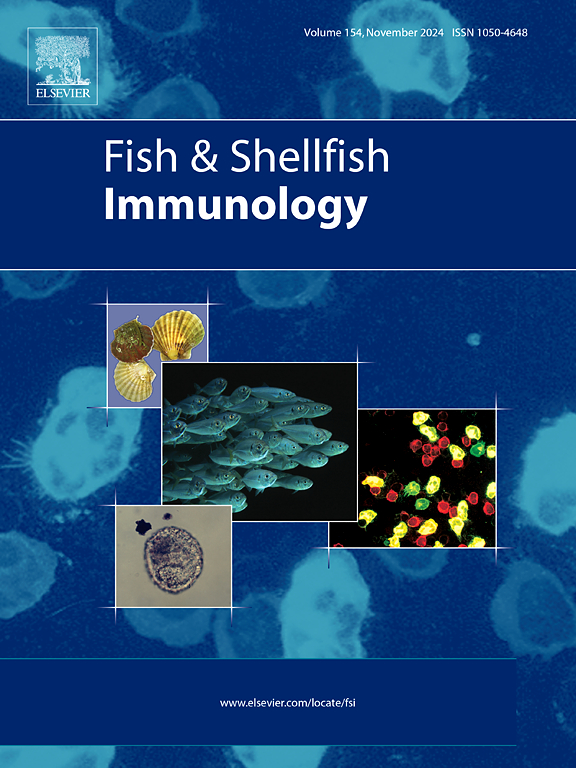SGIV和RGNNV通过介导蛋白酶体和核糖体蛋白的泛素化修饰来调节鱼类的先天免疫反应。
IF 3.9
2区 农林科学
Q1 FISHERIES
引用次数: 0
摘要
新加坡石斑鱼虹膜病毒(SGIV)和红斑石斑鱼神经坏死病毒(RGNNV)分别是影响石斑鱼种群的主要DNA和RNA病毒病原体。蛋白泛素化是一种重要的翻译后修饰,在宿主先天免疫反应和病毒复制过程中起着关键的调节作用。在本研究中,我们采用定量蛋白质组学方法系统地鉴定和表征了SGIV和RGNNV感染后石斑鱼脾脏(Epinephelus akaara, GS)细胞中泛素化修饰蛋白的变化。蛋白质组学分析显示,差异表达蛋白主要富集在核糖体和蛋白酶体相关的信号通路和相关的生物学过程中。STRING分析和相关分析显示,在SGIV和RGNNV感染过程中,泛素- 40s核糖体蛋白S27a (RPS27a)作为一个关键的调控分子,与参与核糖体生物发生和蛋白酶体介导降解的蛋白存在显著的相互作用和功能相关性。机制研究表明,SGIV和RGNNV的复制过程都严重依赖于宿主蛋白酶体系统,病毒对NF-κB信号通路的调节是通过泛素-蛋白酶体系统(UPS)介导的。通过过表达和RNA干扰方法的功能验证表明,石斑鱼ub-RPS27a (Ecub-RPS27a)在病毒感染的GS细胞中显著抑制病毒复制,同时调节先天免疫反应。总的来说,这些发现为SGIV和RGNNV感染过程中控制病毒发病机制和宿主-病原体相互作用的分子机制提供了新的见解。本文章由计算机程序翻译,如有差异,请以英文原文为准。
SGIV and RGNNV regulate fish innate immune responses by mediating ubiquitinated modifications of proteasome and ribosomal proteins
Singapore grouper iridovirus (SGIV) and red-spotted grouper nervous necrosis virus (RGNNV) have been identified as the predominant DNA and RNA viral pathogens, respectively, affecting grouper populations. Protein ubiquitination, a crucial post-translational modification, plays pivotal regulatory roles in both host innate immune responses and viral replication processes. In the present study, we employed quantitative proteomics approaches to systematically identify and characterize alterations in ubiquitination-modified proteins in grouper spleen (Epinephelus akaara, GS) cells following SGIV and RGNNV infection. Proteomic analysis revealed that differentially expressed proteins were predominantly enriched in ribosome- and proteasome-related signaling pathways and associated biological processes. STRING analysis and correlation analysis revealed ubiquitin-40S ribosomal protein S27a (RPS27a) as a key regulatory molecule demonstrating significant interactions and functional correlations with proteins involved in ribosome biogenesis and proteasome-mediated degradation during both SGIV and RGNNV infection. Mechanistic investigations demonstrated that the replication processes of both SGIV and RGNNV are critically dependent on the host proteasome system, with viral regulation of the NF-κB signaling pathway being mediated through the ubiquitin-proteasome system (UPS). Functional validation through overexpression and RNA interference approaches demonstrated that grouper ub-RPS27a (Ecub-RPS27a) significantly inhibits viral replication while modulating innate immune responses in virus-infected GS cells. Collectively, these findings provide novel insights into the molecular mechanisms governing viral pathogenesis and host-pathogen interactions during SGIV and RGNNV infection.
求助全文
通过发布文献求助,成功后即可免费获取论文全文。
去求助
来源期刊

Fish & shellfish immunology
农林科学-海洋与淡水生物学
CiteScore
7.50
自引率
19.10%
发文量
750
审稿时长
68 days
期刊介绍:
Fish and Shellfish Immunology rapidly publishes high-quality, peer-refereed contributions in the expanding fields of fish and shellfish immunology. It presents studies on the basic mechanisms of both the specific and non-specific defense systems, the cells, tissues, and humoral factors involved, their dependence on environmental and intrinsic factors, response to pathogens, response to vaccination, and applied studies on the development of specific vaccines for use in the aquaculture industry.
 求助内容:
求助内容: 应助结果提醒方式:
应助结果提醒方式:


